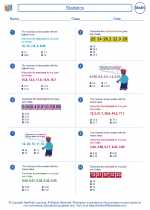Scatter Plot
A scatter plot is a type of mathematical diagram using Cartesian coordinates to display values for two variables for a set of data. The data is displayed as a collection of points, each having the value of one variable determining the position on the horizontal axis and the value of the other variable determining the position on the vertical axis. This allows for the relationship between the two variables to be examined and displayed visually.
Creating a Scatter Plot
To create a scatter plot, you would first need a set of paired data, where each pair represents values of the two variables you want to compare. Once you have your data, you would plot each pair as a point on a graph, with one value determining the point's position along the x-axis, and the other value determining the point's position along the y-axis.
Interpreting a Scatter Plot
When looking at a scatter plot, you can determine the relationship between the two variables by examining the overall pattern of the points. If the points tend to form a straight line that slopes upward from left to right, it indicates a positive correlation. If the points tend to form a straight line that slopes downward from left to right, it indicates a negative correlation. If there is no apparent pattern in the points, it indicates no correlation.
Study Guide for Scatter Plots
- Understand the concept of a scatter plot and how it is used to display data.
- Learn how to create a scatter plot by plotting pairs of data on a graph.
- Interpret the overall pattern of points on a scatter plot to determine the relationship between the variables.
- Practice identifying positive, negative, and no correlation based on the scatter plot.
- Explore real-world examples of scatter plots and how they are used in various fields.
Remember, practice is key to mastering the concept of scatter plots. Try drawing your own scatter plots with different sets of data to gain a deeper understanding of how they work.
.◂Math Worksheets and Study Guides Fifth Grade. Statistics

 Worksheet/Answer key
Worksheet/Answer key
 Worksheet/Answer key
Worksheet/Answer key
 Worksheet/Answer key
Worksheet/Answer key
